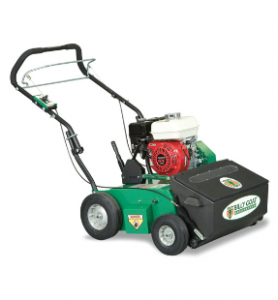 Using a Billy Goat overseeder is easy: just load it with seed, set the seed drop density and cutting depth, and engage the bail when you’re rolling over places you want to seed. However, there’s a lot more to effective overseeding, from choosing the right grass to getting it to take root.
Using a Billy Goat overseeder is easy: just load it with seed, set the seed drop density and cutting depth, and engage the bail when you’re rolling over places you want to seed. However, there’s a lot more to effective overseeding, from choosing the right grass to getting it to take root.
What’s the Point of Overseeding?
A blade of grass lives for about a month and a half. During that period, it extends the roots and sends out new blades of grass, called tillers. Hundreds of these tillers can be produced by the original plant, but as this root network matures, the death of grass blades can out-pace their replacement with new tillers. This causes the lawn to thin out.
When you overseed, you’re starting the growth process over again with new plants. This maintains the replacement of mature blades, keeping your lawn thick and healthy looking. The establishment of new grass also helps push out undesirable weeds like crabgrass.
When Should I Overseed?
The best time to put down grass seed is late in the summer or early in the fall. This gives the new grass time to germinate when it’s still warm, then grow and put down a solid root system as the temperature drops. This helps it survive the winter while taking advantage of fall’s higher soil moisture. When the grass comes out of hibernation, it grows as temperatures warm up, further extending its reach and blocking spring weeds as they germinate.
Preparing Your Lawn for Overseeding
To germinate, the seeds need to make contact with the soil. To get the best results, as much material should be cleared between your seeder and the ground.
Dethatch the grass to remove the layer of decomposing clippings.
Cut the grass to a height of two inches or less. Use a collection system to pick up the clippings and the material lifted up by dethatching.
Aerate the soil to help the seeds penetrate and give them better access to air and water. If you’re using a plug aerator, you will probably want to dethatch and cut the turf first so your mower blades will only need to deal with the core plugs.
If you have lawn issues like bald spots or poor soil quality, these should be corrected before overseeding.
Which Seed Should I Use?
It’s best to match the winter grass you’re laying down with the summer grass currently on your lawn: if you have fescue, get more fescue. Have Bermudagrass? Ryegrass, Bluegrass, and Tall Fescue will work with your turf.
Most fine fescue sold in North America is shade gras so it won’t grow well on open turf. If you want to overseed with this variety, look for something without this label. Ryegrass is available in both annual and perennial forms, so plan your planting accordingly.
How Much Seed Should I Use?
Golf courses use as much as 30 lbs. per acre to deal with the unique needs of course turf, including heavy foot traffic and ball speed consistency. This has led to the misconception that lawns need several times the recommended amount of seed.
As a general rule, you should follow the recommended maximum stated on the seed package if it’s the first time you’re overseeding, and somewhere between the minimum and middle recommendation if you’re reseeding. Most overseeding failures are due to improper care after seeding, not from a lack of seed.
Caring for an Overseeded Lawn
If you’re going to spread fertilizer, do it before seeding so that the seeds stay close to the surface.
Once the grass has been spread, the lawn should be lightly watered two to three times a day to keep the soil moist, but not damp. This will help the seeds germinate. Once the grass starts sprouting, add more water at a time, but do it less frequently so the moisture penetrated deeper without making the ground wet enough to promote root rot.
The existing grass cover should provide enough sun protection for the new seed, but if you have bald spots, these should be raked over with a light later of soil or another covering like straw.
Fertilizer may need to be applied with or directly after overseeding, especially if the soil is low in phosphorus. New seed needs this mineral to grow, but since it doesn’t leach into water like other minerals, it may not be accessible to these new plants. This mineral will be labeled “P,” and it will be the middle number on the fertilizer bag’s content label. Most fertilizers designed for overseeding will include extra phosphorus.
The lawn shouldn’t be mowed again until the new grass is at least two inches tall, which should take two to three weeks. At this point, you can resume your normal watering.
Keeping Your Billy Goat Overseeder Ready for Planting
Need to work on your overseeder? You can get everything you need at www.billygoatparts.com. We’re a certified dealer for Billy Goat and all the engine manufacturers they use including Subaru, Honda, Kohler and Briggs & Stratton, and we ship across the U.S. and Canada.
